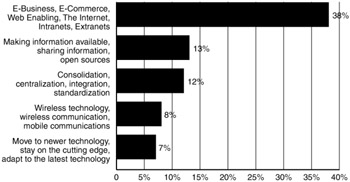Chapter 12: Server Consolidation and Disk Management Simplification
|
| < Day Day Up > |
|
One of the most challenging operational IT issues today is the management burden imposed by having to deal with hundreds of relatively small Wintel servers. Many companies have discovered the benefits of radically simplifying their data center infrastructure. In those enterprises where such an approach has been implemented, major improvements have been realized in their returns on investment (ROI), as well as overall business performance. Tremendous benefits, in particular, have come through server simplification and standardization. By consolidating the number of servers operating within the enterprise and optimizing that platform for the data center or for high-end and mission-critical applications, significant economic savings as well as greatly improved business agility are gained.
Harsh Economic Realities
The business landscape has changed significantly over the past several years. Where technology spending was once a mushrooming part of most corporate budgets, it is now subject to severe cutbacks. In 2001, for instance, IT expenditures actually fell for the first time in a decade. According to a study by Merrill Lynch, most chief information officers (CIOs) revised their budgets at least twice in 2002, and the deepest spending cuts were made in staffing, consulting, and hardware. Unfortunately, Merrill Lynch's prediction of three percent growth in IT spending in 2002 did not take place. Initial predictions of twelve percent growth in 2003 were toned down, with many companies experiencing yet another year of slow or no growth. Yet, now is not the time to engage in another round of layoffs and further curtailment of IT budgets; rather, it is a time of opportunity. While continuing to search for greater internal efficiencies and far-reaching economies of scale, companies should find this to be an excellent time to prepare their IT infrastructures for future growth.
This viewpoint is backed up by a survey of 300 IT managers conducted by the Patrick Marketing Group of Calabasas, California. This survey reveals a lack of any clear-cut direction with regard to their planning for tomorrow. Although most can agree on the importance of E-business/Internet-related technology (38 percent), few other trends have clearly emerged to date as major drivers of change. Based on the survey responses, it appears that technology executives are focusing on information availability/sharing (13 percent), consolidation/centralization (12 percent), wireless/mobile computing (8 percent), and the nebulous issue of "staying on the cutting edge" (7 percent) (Exhibit 1).
Exhibit 1: Most Important Strategic Trends

Looking at this another way, most companies are simply waiting to see what happens. This is a total turnaround from the late 1990s' heyday of technology implementation just for the sake of staying on the cutting edge. While that period lacked any ROI demand for the substantial investment in technology, today's world is predominated by companies treading water. They do not want to risk anything. The scene is set, therefore, for forward-looking enterprises to achieve a competitive advantage by implementing strategically sound technology initiatives. In a year or two, the business press will be extolling the virtues of those few who stepped up to the plate and forged ahead with a technology vision rather than marked time like the rest of the crowd. But, even for those who cannot contemplate the slightest risk, server consolidation is a fairly safe bet.
|
| < Day Day Up > |
|
EAN: N/A
Pages: 197